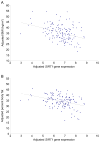SIRT1 is associated with a decrease in acute insulin secretion and a sex specific increase in risk for type 2 diabetes in Pima Indians
- PMID: 21871827
- PMCID: PMC3224181
- DOI: 10.1016/j.ymgme.2011.08.001
SIRT1 is associated with a decrease in acute insulin secretion and a sex specific increase in risk for type 2 diabetes in Pima Indians
Abstract
Genetic variation in SIRT1 affects obesity-related phenotypes in several populations. The purpose of this study was to determine whether variation in SIRT1 affects susceptibility to obesity or type 2 diabetes in Pima Indians, a population with very high prevalence and incidence rates of these diseases. Genotypic data from single nucleotide polymorphisms (SNPs) identified by sequencing regions of SIRT1 combined with SNPs in/near SIRT1 from a prior genome-wide association study determined that 4 tag SNPs (rs7895833, rs10509291, rs7896005, and rs4746720) could capture information across this gene and its adjacent 5' region. The tag SNPs were genotyped in a population-based sample of 3501 Pima Indians (44% had diabetes, 58% female) for association with type 2 diabetes and BMI. Metabolic trait data and adipose biopsies were available on a subset of these subjects. Two tag SNPs, rs10509291 and rs7896005, were nominally associated with type 2 diabetes (P=0.01, OR=1.25 95%CI 1.05-1.48, and P=0.02, OR=1.17 95%CI 1.02-1.34, respectively; additive P values adjusted for age, sex, birth year, and family membership), but not BMI (adjusted P values 0.52 and 0.45, respectively). Among metabolically characterized subjects with normal glucose tolerance (N=243), those carrying the diabetes risk allele (T) for rs10509291 and (G) for rs7896005 had a reduced acute insulin response (AIR) to an intravenous glucose bolus (adjusted P=0.045 and 0.035, respectively). SIRT1 expression in adipose biopsies was negatively correlated with BMI (adjusted P=0.00001). We conclude that variation in SIRT1 is nominally associated with reduced AIR and increased risk for type 2 diabetes. SIRT1 expression in adipose is correlated with BMI, but it remains unknown whether this is a cause or consequence of obesity.
Published by Elsevier Inc.
Conflict of interest statement
Figures


References
-
- Kelly G. A review of the sirtuin system, its clinical implications, and the potential role of dietary activators like resveratrol: part 1. Altern Med Rev. 2010;15:245–263. - PubMed
-
- Yang T, Fu M, Pestell R, Sauve AA. SIRT1 and endocrine signaling. Trends Endocrinol Metab. 2006;17:186–191. - PubMed
-
- Rodgers JT, Lerin C, Haas W, Gygi SP, Spiegelman BM, Puigserver P. Nutrient control of glucose homeostasis through a complex of PGC-1alpha and SIRT1. Nature. 2005;434:113–118. - PubMed
-
- Frescas D, Valenti L, Accili D. Nuclear trapping of the forkhead transcription factor FoxO1 via Sirt-dependent deacetylation promotes expression of glucogenetic genes. J Biol Chem. 2005;280:20589–20595. - PubMed
Publication types
MeSH terms
Substances
Grants and funding
LinkOut - more resources
Full Text Sources
Medical

